AUDI A5 2020 Owners Manual
Manufacturer: AUDI, Model Year: 2020, Model line: A5, Model: AUDI A5 2020Pages: 302, PDF Size: 81.67 MB
Page 91 of 302

8W7012721BA
Stowing and using
— Glove compartment: the glove compartment
can be locked using the mechanical key
=> page 34.
— Storage compartments in the door trim panels
— Storage compartment in the center console
— Storage compartment under the front center
armrest
— Storage compartment in the rear center arm-
rest
— Storage compartment under the light switch
— Nets on the backrests of the front seats
— Garment hooks above the rear doors
— Nets on the left/right luggage compartment
trim panel
—Tie-downs on the left/right luggage compart-
ment trim panel
— Bag hooks in the luggage compartment
ZA\ WARNING
—To reduce the risk of injury, make sure all
storage compartments are always closed
while driving.
— Loose objects can be thrown around the ve-
hicle interior during sudden driving or brak-
ing maneuvers, which increases the risk of
an accident. Store objects securely while
driving.
— Only use the storage compartments in the
door trim panels to store small objects that
will not stick out of the compartment and
impair the function of the side airbags.
— Due to strength reasons, only secure objects
up to 11 lbs (5 kg) with the tie-downs*.
Heavier objects are not adequately secured.
There is risk of personal injury.
— Applies to: vehicles with garment hooks: On-
ly lightweight clothing should be hung from
the garment hooks in the vehicle. Do not use
clothes hangers to hang clothing. The pock-
ets of the clothing must not contain any
heavy, breakable, or sharp-edged objects.
This could impair the effectiveness of the
side curtain airbags.
— Make sure your view toward the rear is not
blocked, for example by hanging clothing or
objects in the vehicle.
Luggage compartment
General information
All pieces of luggage or objects must be securely
fastened in the luggage compartment. Note the
following to maintain good vehicle handling:
> Distribute the load evenly in the luggage com-
partment.
> Stow heavy luggage as far forward in the lug-
gage compartment as possible.
» Use non-elastic cords attached to the tie-downs
to secure objects.
ZA\ WARNING
— Applies to: vehicles with luggage compart-
ment cover: The luggage compartment cov-
er is not a surface for storing objects. Ob-
jects placed on the cover increase the risk of
injury to all vehicle occupants during sudden
driving or braking maneuvers or in the event
of an accident.
— Applies to: vehicles with luggage compart-
ment cover: The luggage compartment cov-
er must always be securely fastened when in
use to reduce the risk of an accident.
— Loose objects can be thrown around the ve-
hicle interior during sudden driving or brak-
ing maneuvers, which increases the risk of
an accident. Always stow objects securely in
the luggage compartment and secure them
at the tie-downs. Use straps suitable for
heavy objects.
—If pieces of luggage or objects are secured
to the tie-downs with unsuitable or dam-
aged straps, this can increase the risk of in-
jury during braking maneuvers or accidents.
— When transporting heavy objects, the vehi-
cle characteristics will change due to the
shift in the center of gravity, which increases
the risk of an accident. You may need to
adapt your driving style and speed to the
current conditions.
— The cargo net is only strong enough to se-
cure light objects. Heavy objects are not ade-
quately secured. Attempting to secure heavy
objects increases the risk of injury.
89
Page 92 of 302
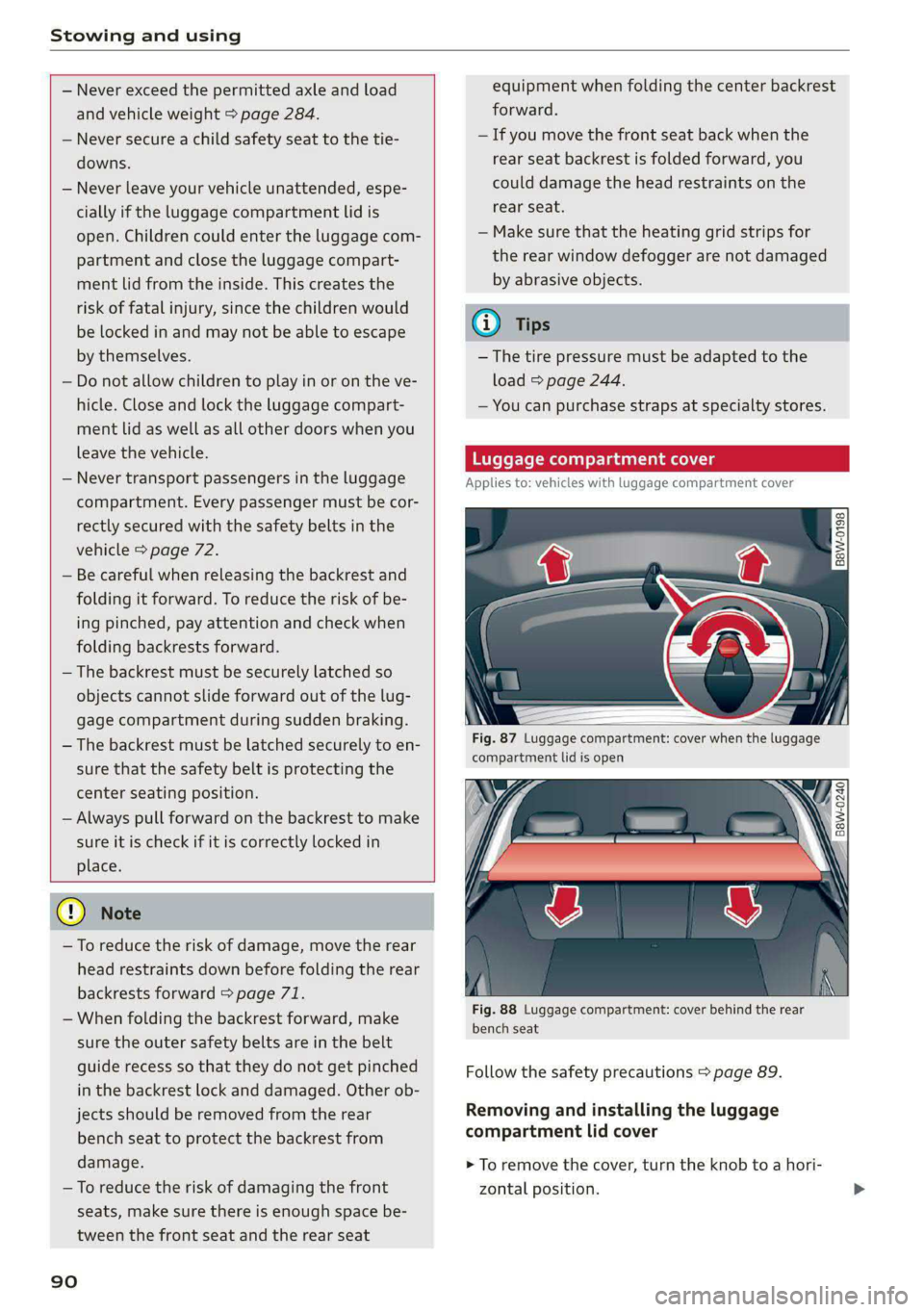
Stowing and using
— Never exceed the permitted axle and load
and vehicle weight > page 284.
— Never secure a child safety seat to the tie-
downs.
— Never leave your vehicle unattended, espe-
cially if the luggage compartment lid is
open. Children could enter the luggage com-
partment and close the luggage compart-
ment lid from the inside. This creates the
risk of fatal injury, since the children would
be locked in and may not be able to escape
by themselves.
— Do not allow children to play in or on the ve-
hicle. Close and lock the luggage compart-
ment lid as well as all other doors when you
leave
the vehicle.
— Never transport passengers in the luggage
compartment. Every passenger must be cor-
rectly secured with the safety belts in the
vehicle > page 72.
— Be careful when releasing the backrest and
folding
it forward. To reduce the risk of be-
ing pinched, pay attention and check when
folding backrests forward.
— The backrest must be securely latched so
objects cannot slide forward out of the lug-
gage compartment during sudden braking.
— The backrest must be latched securely to en-
sure that the safety belt is protecting the
center seating position.
— Always pull forward on the backrest to make
sure it is check if it is correctly locked in
place.
© Note
—To reduce the risk of damage, move the rear
head restraints down before folding the rear
backrests forward = page 71.
— When folding the backrest forward, make
sure the outer safety belts are in the belt
guide recess so that they do not get pinched
in the backrest lock and damaged. Other ob-
jects
should be removed from the rear
bench seat to protect the backrest from
damage.
— To reduce the risk of damaging the front
seats, make sure there is enough space be-
tween the front seat and the rear seat
90
equipment when folding the center backrest
forward.
— If you move the front seat back when the
rear seat backrest is folded forward, you
could damage the head restraints on the
rear seat.
— Make sure that the heating grid strips for
the rear window defogger are not damaged
by abrasive objects.
G) Tips
— The tire pressure must be adapted to the
load > page 244.
— You can purchase straps at specialty stores.
ggage compartment cover
Applies to: vehicles with luggage compartment cover
| Bw-0198
|
Fig. 87 Luggage compartment: cover when the luggage
compartment lid is open
Fig. 88 Luggage compartment: cover behind the rear
bench seat
Follow the safety precautions > page 89.
Removing and installing the luggage
compartment lid cover
> To remove the cover, turn the knob to a hori-
zontal position.
Page 93 of 302

8W7012721BA
Stowing and using
> Pull the cover out of the retainers in the direc- > Fold the backrest back up again until it locks in-
tion of the arrow & fig. 87. to place and the red marking (8) is no longer
> To install the cover, slide it upward onto the re- visible.
tainers and let it lock into place.
» Turn the knob to a vertical position. Folding the center rear backrest forward and
backward
Removing and installing the cover behind Applies to: Sportback
the rear bench seat > Pull on the upper release lever @ and fold the
> To remove the cover, pull it in the direction of backrest forward @).
the arrow ° fig. 88. » Fold the backrest backward until it locks into
> Release it upward. place.
> To install the cover, insert the left and right Applies to: vehicles with lockable backrests in the rear and a
sides of the cover into the mounts on the side lockable pass-through.
trim panel. To prevent access to the luggage compartment
> Slide the cover forward until it locks into place. from the vehicle interior, the backrest can be
locked with the mechanical key © when it is
Increasing the size of the vehicle interior latched in place and the pass-through can be
Applies to: vehicles with folding backrests locked = page 92. You can only enlarge the lug-
gage compartment if the backrest is not locked.
oO r2) Rg
“ 0 oO Increasing the size of the luggage
compartment
Applies to: vehicles with release lever in the luggage compart-
ment
a s
e 3 S 8
B8W-0118
NVI
Applies to: Coupe:
Fig. 91 Luggage compartment: release lever
B8W-0265
Fig. 90 Center backrest: folding in* the center backrest
The rear seat backrests can be folded forward ei-
ther separately* or together.
Follow the safety precautions > page 89.
Folding the outer* rear backrests forward
and backward
Applies to: Cabriolet:
Fig. 92 Luggage compartment: release lever
> Pull the release lever (A) in the direction of the
arrow and fold the backrest forward.
91
Page 94 of 302
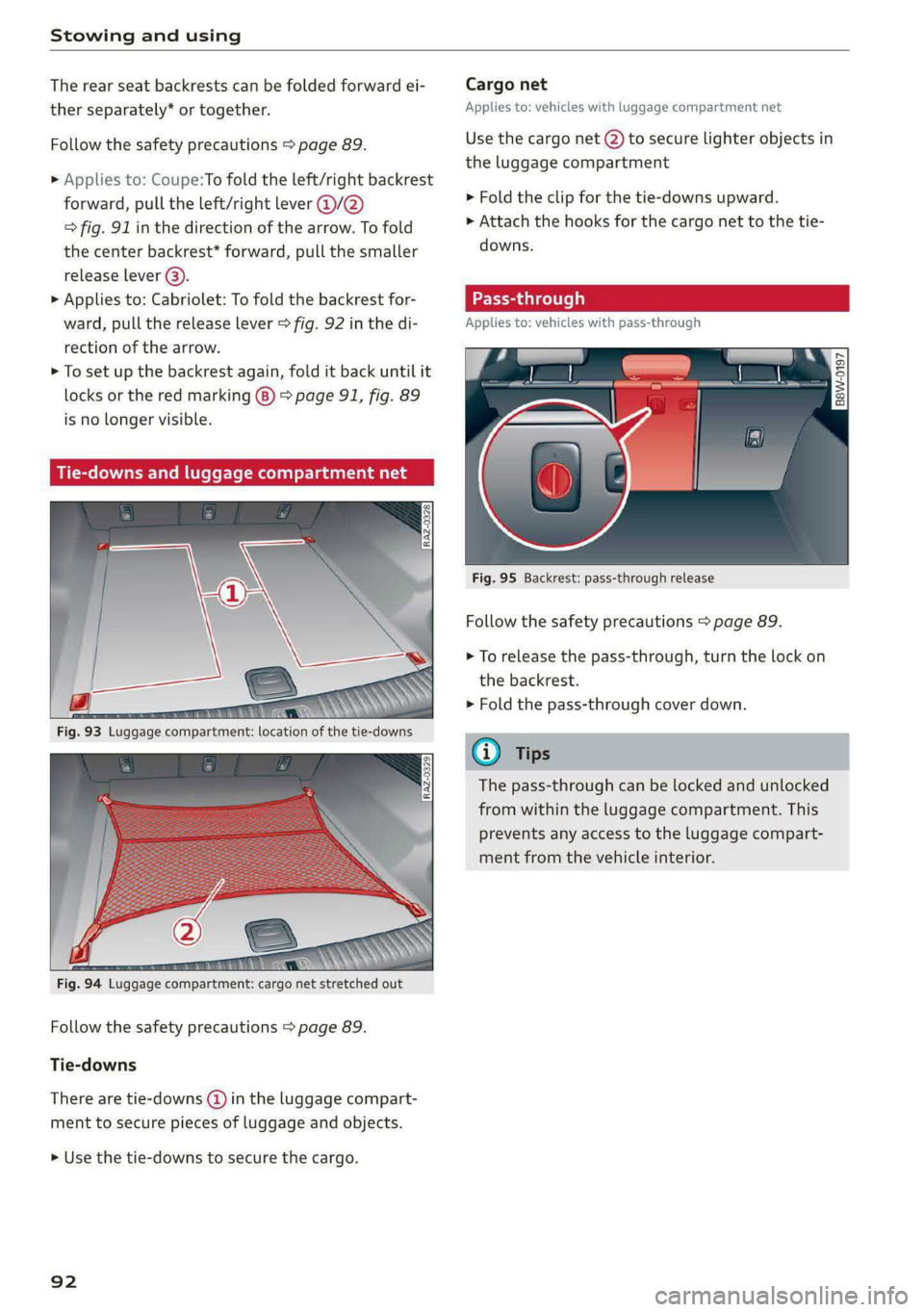
Stowing and using
The rear seat backrests can be folded forward ei- Cargo net
ther separately* or together. Applies to: vehicles with luggage compartment net
Follow the safety precautions > page 89. Use the cargo net (2) to secure lighter objects in
the luggage compartment
> Applies to: Coupe:To fold the left/right backrest
forward, pull the left/right lever ©@/@ > Fold the clip for the tie-downs upward.
© fig. 91 in the direction of the arrow. To fold » Attach the hooks for the cargo net to the tie-
the center backrest* forward, pull the smaller downs.
release lever (3).
> Applies to: Cabriolet: To fold the backrest for-
ward, pull the release lever > fig. 92 in the di- Applies to: vehicles with pass-through
rection of the arrow.
> To set up the backrest again, fold it back until it
locks or the red marking (8) > page 91, fig. 89
is no longer visible.
Tie-downs and luggage comp
Fig. 95 Backrest: pass-through release
Follow the safety precautions > page 89.
> To release the pass-through, turn the lock on
the backrest.
> Fold the pass-through cover down.
@) Tips
The pass-through can be locked and unlocked
from within the luggage compartment. This
prevents any access to the luggage compart-
ment from the vehicle interior.
al. eum Ld
Fig. 93 Luggage compartment: location of the tie-downs
Follow the safety precautions > page 89.
Tie-downs
There are tie-downs (a) in the luggage compart-
ment to secure pieces of luggage and objects.
> Use the tie-downs to secure the cargo.
92
Page 95 of 302
![AUDI A5 2020 Owners Manual 8W7012721BA
Stowing and using
Juels ]
Fig. 96 Luggage compartment: cargo mat spread out
lengthwise
Fig. 97 Luggage compartment:
lengthwise cargo mat
L) crosswise cargo mat / AUDI A5 2020 Owners Manual 8W7012721BA
Stowing and using
Juels ]
Fig. 96 Luggage compartment: cargo mat spread out
lengthwise
Fig. 97 Luggage compartment:
lengthwise cargo mat
L) crosswise cargo mat /](/img/6/57566/w960_57566-94.png)
8W7012721BA
Stowing and using
Juels ]
Fig. 96 Luggage compartment: cargo mat spread out
lengthwise
Fig. 97 Luggage compartment:
lengthwise cargo mat
L) crosswise cargo mat /
The cargo mat protects the luggage compart-
ment and bumper from dirt and scratches. You
can use both sides of the cargo mat.
Follow the safety precautions > page 89.
> To protect the luggage compartment and
bumper when loading and unloading objects,
lay the cargo mat out lengthwise with the
backrests folded down or upright > fig. 96.
> After loading or unloading, fold up the cargo
mat and close the luggage compartment lid.
> To also protect the side trim panels, lay the car-
go mat out widthwise.
> To divide the loading surfaces into separate sec-
tions > fig. 97, fold the cargo mat.
> Only store the cargo mat if it is dry.
You can save room by storing the cargo mat at
the sides of the luggage compartment.
Roof rack
Applies to: vehicles with roof rack mount
BeW-0245
Applies to: Coupe
Fig. 98 Roof: mounting points
BaWw-0244
Applies to: Sportback
Fig. 99 Roof: mounting points
If luggage or cargo is to be carried on the roof,
you must observe the following:
— These roof racks are the basis for a complete
roof rack system. Only roof racks that are suita-
ble for your vehicle may be used. Roof racks and
attachments from the Audi Genuine Accesso-
ries program are recommended.
— Make sure the roof rack is mounted on the vehi-
cle only at the specified locations.
— Note the permitted axle load, permitted total
weight, and permitted roof load of your vehicle
=> page 284. The roof load is the total of the
weight of the roof rack, the attachments and
the cargo you are carrying. However, you must >
93
Page 96 of 302
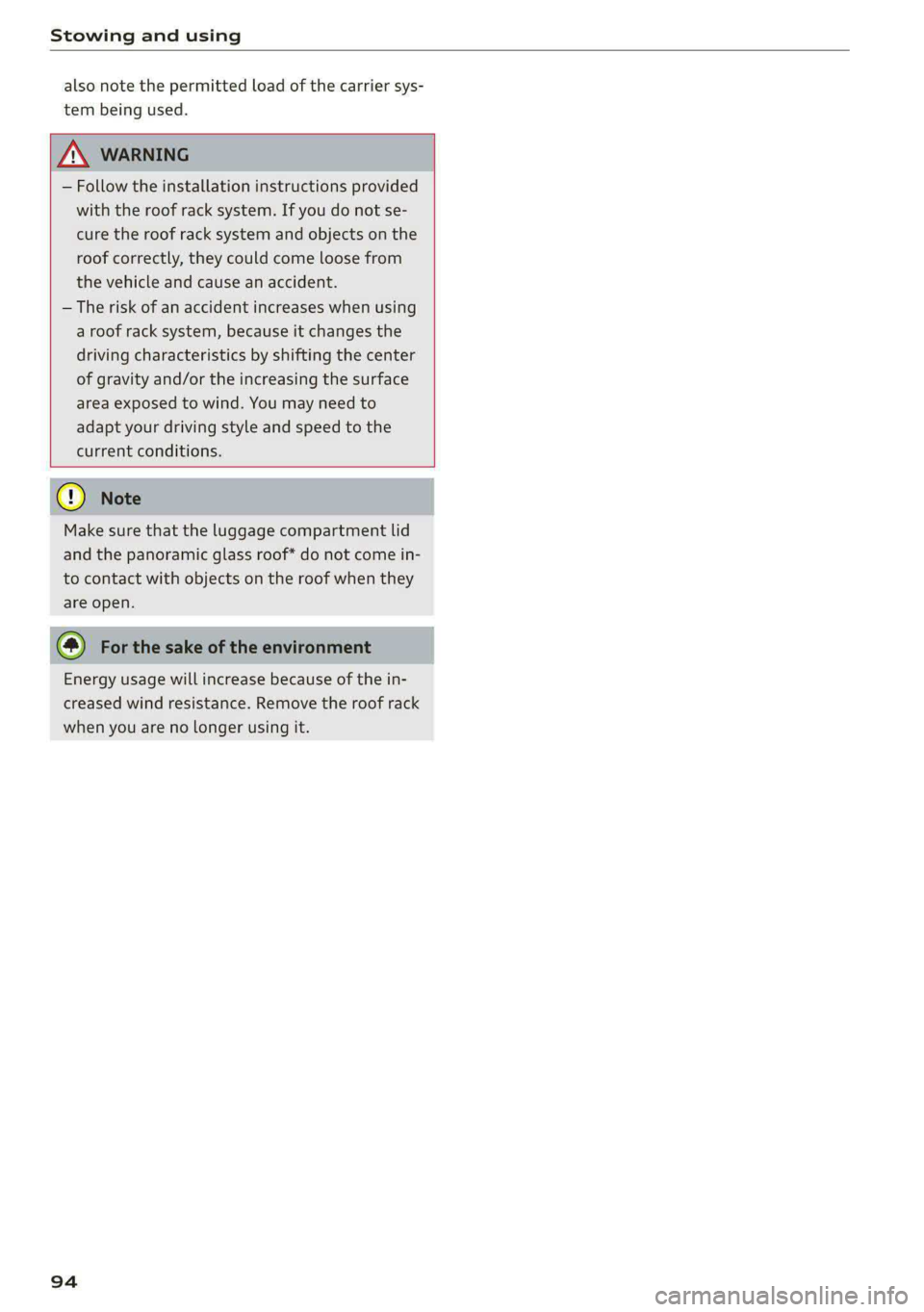
Stowing and using
also note the permitted load of the carrier sys-
tem being used.
— Follow the installation instructions provided
with the roof rack system. If you do not se-
cure the roof rack system and objects on the
roof correctly, they could come loose from
the vehicle and cause an accident.
— The risk of an accident increases when using
a roof rack system, because it changes the
driving characteristics by shifting the center
of gravity and/or the increasing the surface
area exposed to wind. You may need to
adapt your driving style and speed to the
current conditions.
Make sure that the luggage compartment lid
and the panoramic glass roof* do not come in-
to contact with objects on the roof when they
are open.
Energy usage will increase because of the in-
creased wind resistance. Remove the roof rack
when you are no longer using it.
Page 97 of 302
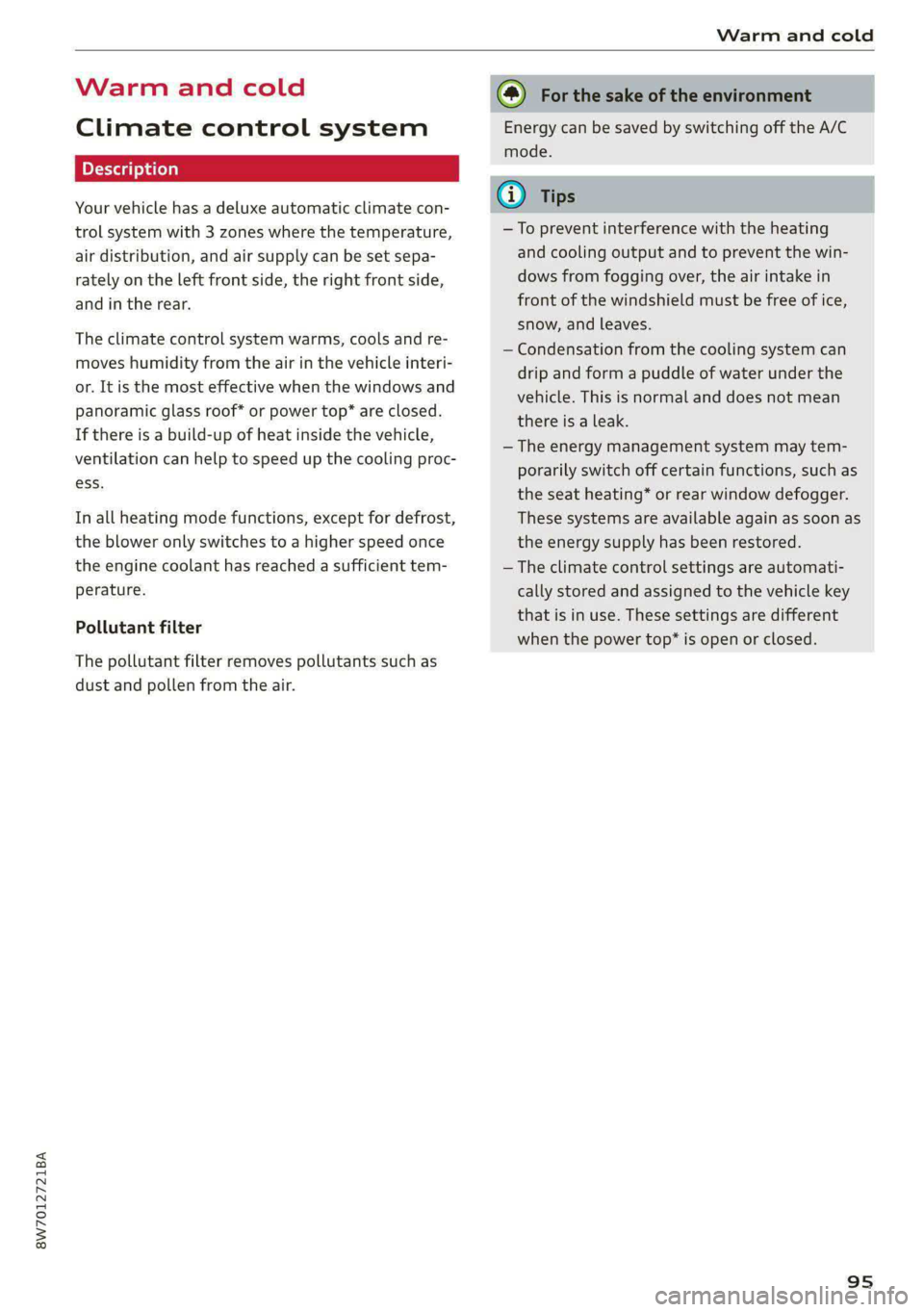
8W7012721BA
Warm and cold
Warm and cold
Climate control system
Your vehicle has a deluxe automatic climate con-
trol system with 3 zones where the temperature,
air distribution, and air supply can be set sepa-
rately on the left front side, the right front side,
and in the rear.
The climate control system warms, cools and re-
moves humidity from the air in the vehicle interi-
or. It is the most effective when the windows and
panoramic glass roof* or power top* are closed.
If there is a build-up of heat inside the vehicle,
ventilation can help to speed up the cooling proc-
ess.
In all heating mode functions, except for defrost,
the blower only switches to a higher speed once
the engine coolant has reached a sufficient tem-
perature.
Pollutant filter
The pollutant filter removes pollutants such as
dust and pollen from the air.
(@) For the sake of the environment
Energy can be saved by switching off the A/C
mode.
@) Tips
—To prevent interference with the heating
and cooling output and to prevent the win-
dows from fogging over, the air intake in
front of the windshield must be free of ice,
snow, and leaves.
— Condensation from the cooling system can
drip and form a puddle of water under the
vehicle. This is normal and does not mean
there is a leak.
— The energy management system may tem-
porarily switch off certain functions, such as
the seat heating* or rear window defogger.
These systems are available again as soon as
the energy supply has been restored.
—The climate control settings are automati-
cally stored and assigned to the vehicle key
that is in use. These settings are different
when the power top* is open or closed.
95
Page 98 of 302
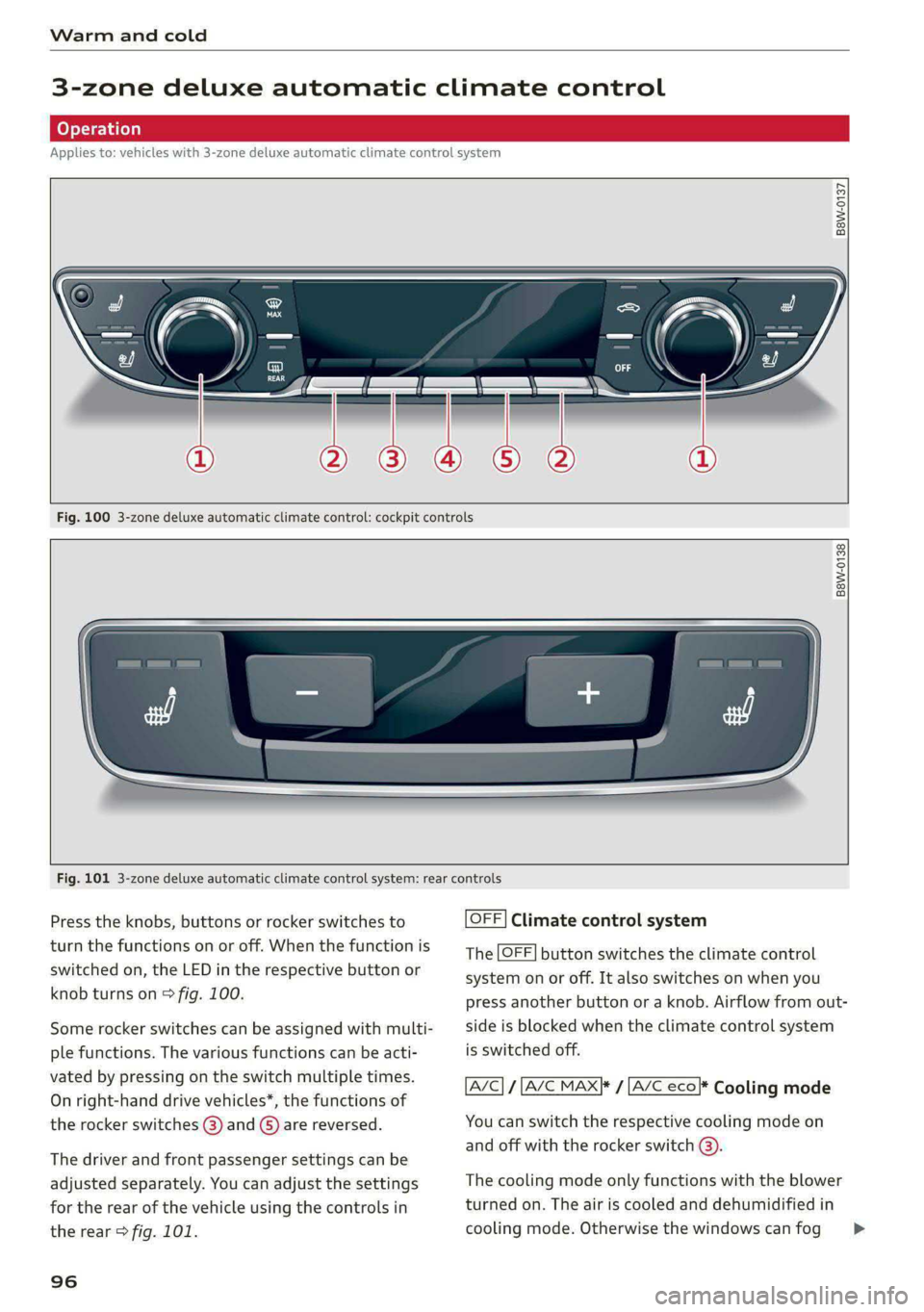
Warm and cold
3-zone deluxe automatic climate control
Applies to: vehicles with 3-zone deluxe automatic climate control system
B8W-0137
Fig. 100 3-zone deluxe automatic climate control: cockpit controls
B8W-0138
Fig. 101 3-zone deluxe automatic climate control system: rear controls
Press the knobs, buttons or rocker switches to
turn the functions on or off. When the function is
switched on, the LED in the respective button or
knob turns on > fig. 100.
Some rocker switches can be assigned with multi-
ple functions. The various functions can be acti-
vated by pressing on the switch multiple times.
On right-hand drive vehicles*, the functions of
the rocker switches @) and ©) are reversed.
The driver and front passenger settings can be
adjusted separately. You can adjust the settings
for the rear of the vehicle using the controls in
the rear > fig. 101.
96
OFF] Climate control system
The OFF] button switches the climate control
system on or off. It also switches on when you
press another button or a knob. Airflow from out-
side is blocked when the climate control system
is switched off.
A/C} / [A/C MAX|* / [A/C eco}* Cooling mode
You can switch the respective cooling mode on
and off with the rocker switch @).
The cooling mode only functions with the blower
turned on. The air is cooled and dehumidified in
cooling mode. Otherwise the windows can fog >
Page 99 of 302
![AUDI A5 2020 Owners Manual 8W7012721BA
Warm and cold
up. The cooling mode switches off automatically
at low outside temperatures.
If you activate [A/C ON], the cooling mode will be
automatically regulated. |A/C OFF AUDI A5 2020 Owners Manual 8W7012721BA
Warm and cold
up. The cooling mode switches off automatically
at low outside temperatures.
If you activate [A/C ON], the cooling mode will be
automatically regulated. |A/C OFF](/img/6/57566/w960_57566-98.png)
8W7012721BA
Warm and cold
up. The cooling mode switches off automatically
at low outside temperatures.
If you activate [A/C ON], the cooling mode will be
automatically regulated. |A/C OFF] switches cool-
ing mode off.
If you activate [A/C MAX}*, the cooling mode will
operate with maximum output. To reduce unnec-
essary energy usage, only use this function brief-
ly.
If you activate [A/C eco}*, the climate control sys-
tem will operate in energy-saving mode.
<= Recirculation mode
In recirculation mode, the air inside the vehicle is
circulated and filtered. This prevents the unfil-
tered air outside the vehicle from entering the
vehicle interior > A\.
Pressing the <> button switches recirculation
mode on or off manually. You can also switch the
recirculation mode off by pressing the knob @ or
the ® button.
AUTO} Automatic mode
Automatic mode maintains a constant tempera-
ture inside the vehicle. Air temperature, airflow
and air distribution are controlled automatically.
You can switch automatic mode on or off by
pressing the knob ().
Temperature
You can adjust the temperature between 60°F
(+16°C) and 84°F (+28°C) by turning the knob
©. If outside of this range, LO or HI will appear
in the climate control system display. In both set-
tings, the climate control runs constantly at the
maximum cooling or heating level. The tempera-
ture is not regulated.
The temperature can be adjusted in the rear us-
ing
the rear controls > fig. 101.
= Blower
You can adjust the volume of air generated by the
blower to your preference using the rocker switch
@. The blower should always run at a low setting
to prevent the windows from fogging and to en-
sure a continuous exchange of air inside the vehi-
cle. To have the blower regulated automatically,
press one of the knobs (4).
Air distribution
You can use the rocker switches (2) to adjust the
vents where the air will flow out of. Press the
rocker switches (2) repeatedly until the desired
air distribution setting is displayed in the climate
control system controls. To have the air distribu-
tion regulated automatically, press one of the
knobs (a).
SYNC] Synchronization
Use the rocker switch ©) to select the function.
When synchronization is switched on, the set-
tings for the driver's side are applied to the front
passenger's side and the rear (except for seat
heating/ventilation*). When the settings on the
front passenger's side or in the rear are changed,
the synchronization is automatically switched off
and 3-ZONE appears in the display.
SET REAR] Function
Use the rocker switch () to select the function.
When the function is switched on, you can adjust
all settings for the rear using the climate control
system controls in the cockpit. The rear climate
control system controls cannot be operated at
the same time. This function switches off auto-
matically after a certain period of time or after
leaving the menu.
#/ Seat heating*
The seat heating temperature can be set at mul-
tiple levels. Press the w button once to switch on
the highest level. Press the a button again to de-
crease the temperature one level at a time. The
seat heating is off when all of the LEDs are off.
#5 Seat ventilation*
The seat ventilation intensity can be set to multi-
ple levels. Press the £J button once to switch on
the highest level. Press the #J button again to
decrease the intensity one level at a time. The
seat ventilation is off when all of the LEDs are off. >
97
Page 100 of 302

Warm and cold
—} Neck heating*
Applies to: vehicles with neck heating
The neck heating temperature can be set at mul-
tiple levels. Press the J button once to switch on
the highest level. Press the 3 button again to de-
crease the temperature one level at a time. The
neck heating is off when all of the LEDs are off.
a Seat heating and ventilation*
Applies to: vehicles with seat heating/ventilation
If you press the # button, you can turn either the
seat ventilation or the seat heating on or off.
— If you turn the knob @ clockwise, you will turn
the seat heating down to the lowest level (1).
The red LED in the button turns on. To increase
the temperature, keep turning clockwise to the
highest level (3).
— If you turn the knob @ counterclockwise, you
will turn the seat ventilation down to the low-
est level (1). The blue LED in the button turns
on. To increase the ventilation, keep turning
counterclockwise to the highest level (3).
® Defrosting
The windshield and side windows are defrosted
or cleared of condensation as quickly as possible.
The maximum amount of air flows mainly from
the vents below the windshield. Recirculation
mode switches off. The temperature should be
set at +72°F (+22°C) or higher. The temperature
is controlled automatically.
You can switch the defroster on or off using the
X& button. You can switch the function off by
pressing a knob ().
@ Rear window defogger
The rear window defogger only operates when
the engine is running. It switches off automati-
cally after 10 to 20 minutes, depending on the
outside temperature.
To prevent the rear window defogger from
switching off automatically, press and hold & for
more than three seconds. This is stored until the
ignition is switched off.
98
Vents
You can open or close the center and rear vents in
the cockpit and the vents in the rear center con-
sole using the ridged thumbwheels. The levers
adjust the direction of the airflow from the vents.
Residual heat
You can activate the residual heat function when
the ignition is switched off by pressing the knob
@ (left side). The residual heat from the coolant
is used to heat the vehicle interior. The residual
heat function switches off automatically after
about 15 minutes.
ZA WARNING
— You should not use the recirculation mode
for an extended period of time, because no
fresh air is drawn in and the windows can
fog
when cooling mode is switched off. This
increases the risk of an accident.
— Individuals with reduced sensitivity to pain
or temperature could develop burns when
using the seat heating* or neck heating*
functions. To reduce the risk of injury, these
individuals must not use the seat or neck
heating*.
— If the air vents in the seats are covered by
clothing or similar objects when the neck
heating* is switched on, the output from the
neck heating may become very hot tempora-
rily. This can cause burns on unprotected
skin exposed directly to the vents.
@) Note
To reduce the risk of damage to the seat heat-
ing* elements, do not kneel on the seats or
place heavy pressure on one area of the seat.
@) Tips
— When the power top” is closed, the neck
heating* will switch automatically from set-
ting 3 to setting 2 after approximately six
minutes.
— The heat output from the neck heating" is
lower when the power top* is closed than
when it is open.